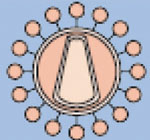Infectious agents
Scientific names
Tables 1.1 and 1.2 referred to Plasmodium falciparum as an infectious agent causing malaria. This is an example of how infectious agents are named scientifically, using a combination of two words, the 'genus' and the 'species' names. The genus name is written with its initial letter capitalised, followed by the species name which is not capitalised. In the example above, Plasmodium is the genus name and falciparum refers to one of the species of this genus found in Ethiopia. There are other species in this genus, which also cause malaria, e.g. Plasmodium vivax.
Sizes and types of infectious agents
Infectious agents can have varying sizes. Some, such as Plasmodium falciparum and all bacteria and viruses, are tiny and are called micro-organisms, because they can only be seen with the aid of microscopes. Others, such as the ascaris worm (Ascaris lumbricoides), can be easily seen with the naked eye. The different types of infectious agents are illustrated in Table 1.3 according to their size, starting with the largest and ending with the smallest, and are then discussed below.
Table 1.3 Different types of infectious agents: their number of cells, visibility and examples
| Type of infectious agent | Number of cells | Visibility | Examples | |
|---|---|---|---|---|
|
Helminths |
many |
Visible with the naked eye |
Ascaris worm causes ascariasis
Its length reaches 15–30 cm |
 |
|
Protozoa |
1 |
Visible with a standard microscope |
Plasmodium falciparum causes malaria |  |
|
Bacteria |
1 | Visible only with a special microscope; much smaller in size than protozoa | Vibrio cholerae causes cholera |  |
|
Viruses |
0 | Visible only with a special microscope; much smaller in size than bacteria | HIV causes AIDS |  |
Helminths are worms made up of many cells; for example, Ascaris lumbricoides.
Protozoa are micro-organisms made up of one cell; for example, Plasmodium falciparum.
Bacteria are also micro-organisms made up of one cell, but they are much smaller than protozoa and have a different structure; for example Vibrio cholerae, which causes cholera.
Viruses are infectious agents that do not have the structure of a cell. They are more like tiny boxes or particles and are much smaller than bacteria; for example, HIV (the Human Immunodeficiency Virus), which can lead to AIDS.
Though not as common as causes of communicable disease in humans, other types of infectious agents include fungi (e.g. ringworm is caused by a fungus infection), and mites (similar to insects), which cause scabies.